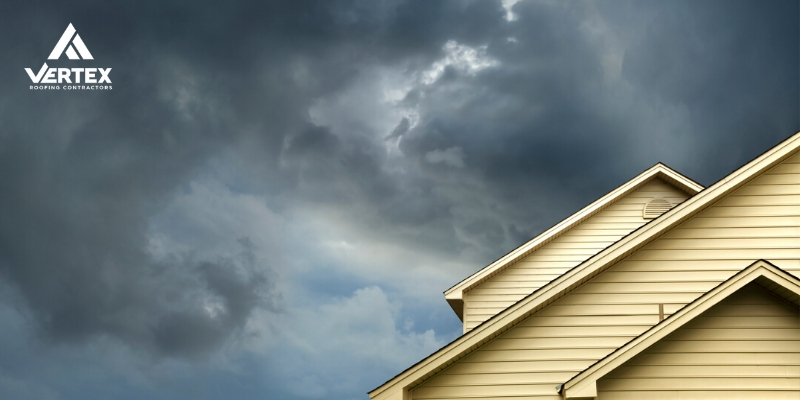Naturally, storms awe us all with their demonstrations of the overwhelming power of nature — astounding lightning, jarring thunder, intense winds, torrential rains. Yet, after a big storm passes, people tend to forget about it so quickly that it doesn't even occur to them to check for roof damage. That's a serious oversight because roof damage from a storm can put your home's structure, contents, and the occupants living in it at serious risk. So, a roof inspection should be your first priority after a storm.
Inspecting Your Roof for Storm Damage
You need to be able to rely on your home's roof to protect you and your property from weather, but your roof is the part of your property that is most susceptible to damage from storms. Prompt attention can help you avoid potentially extreme structural damage, mold, destruction of personal property, and health and safety hazards.
Many people are not sure how to inspect a roof for damage after a storm.
Here are basic steps for inspecting your roof, which you can do by walking around your house after a storm:
1. Look for debris on the roof
Look for tree limbs or other large pieces of debris that have fallen or been blown onto the roof. Sharp ends of downed branches can puncture the shingles and moisture barrier, and the weight of heavy debris can stress your roof.
2. Check for holes in the roof
Locate areas of the roof with missing sections of the roof, split seams, cracked or punctured sealant, and broken or cracked skylights. These can directly expose your home's interior to the outside elements.
3. Look for areas with missing roof tiles or shingles
Missing or loose shingles or tiles may leave the felt underlayment, water, and ice barrier, and plywood roof decking exposed to rain, snow and ice that can enter your home. Missing roof covering materials should be replaced promptly.
4. Check for dented, bruised or cracked roof covering materials
Storm damage can cause loss of granules on asphalt shingles, leaving the surfaces exposed to sun and reducing their integrity and lifespan. Cracked or broken slate tiles, wood shakes, concrete shingles can expose underlayment and decking to water and ice. That can further damage the roof and expose your home's interior to leaks.
5. Check for damaged metal edging
Check for loose, displaced, dented or otherwise damaged or missing flashing or other metal edging around attic rafter vents, chimneys, gutters, skylights, and along junctions between roofs and dormers. These are critical for directing water flow away from seams and edges of openings.
6. Check for signs of water leaks on ceilings or walls
Water stains, bulging spots or separated paint that might be lead based on ceilings or interior walls can signal a roof leak that is probably already damaging the structure of your house. Leaks require urgent attention.
Roof Damage Restoration Process
Take pictures of the damaged areas of your roof. Contact your homeowner's insurance claims department to discuss what actions you should take. Your insurance agent is likely to suggest that you obtain a bid for roof repairs or replacement.
- Your roof repair contractor will examine the roof, provide you with an estimate of all materials and labor costs for repair or replacement, and explain the installation process and warranties.
- Your roofing contractor will work with your home insurance company, help you throughout the claims process, and submit a certified invoice to your insurer after the work is completed.
- Your insurance company will review the roof damage and repair estimate and provide you with a report of the damage reimbursement funds you will receive.
Remember, After a Storm…
To protect yourself and your investment, always inspect your roof promptly after storms, identify and document even minor roof damage, and have the necessary repairs made as soon as possible. Remove debris from the roof, and cover any open areas of the roof with a temporary waterproof covering.
Your home insurance policy will probably pay for your roof repairs or replacement. But, review your policy provisions to be clear on your deductibles, coverage limits, and the time limit for filing a claim for storm damage.
Vertex Roofing Contractors, Salt Lake City, UT
We help homeowners with prompt and top-quality roof repairs and replacements of storm-damaged roofs. Our expert team is fully certified, licensed, and insured. We offer our customers 24-hour Quick Quote service and a complete satisfaction guarantee. We also provide among our industry's best warranties, and special financing for approved credit.
If your home's roof has been damaged by a storm, call Vertex Roofing Contractors, Salt Lake City, Utah at (801) 639-0477, to schedule an appointment for a free estimate, or visit our website for general information.
- What Is Included in a Commercial Roof Inspection? - April 17, 2024
- Upgrade Your Home's Curb Appeal this May with a Beautiful New Roof in Salt Lake City - May 30, 2023
- Composite Roofing in Utah: Types, Benefits, and Costs - March 31, 2023


